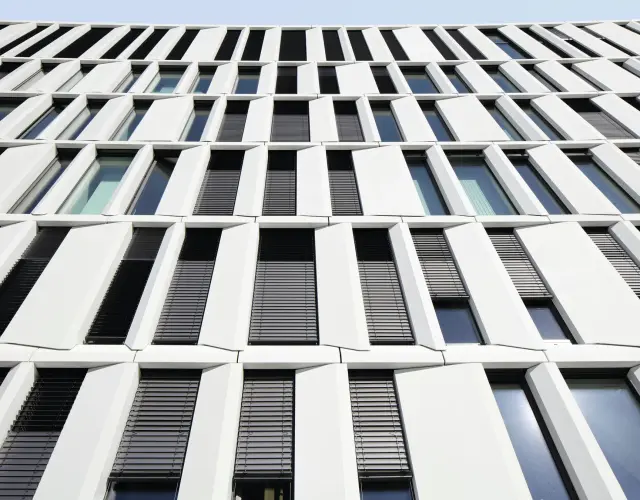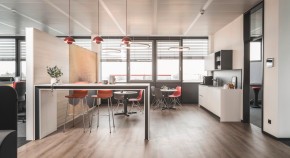
WAREMA contact & support Service for architects
- Back
- Home
- Services & Tools
- Contact person
Find your direct contact for personalised advice and support. Our team of experts will provide you with competent support.
Hotline for architects
With this service, you'll always be on the safe side during your planning work and can explore all of your options:
- Competent consulting and technical clarification
- Standard & project-related solutions
- Creation of installation diagrams
- Preparation of CAD files and tender specifications
- Organisation and supply of samples
- Arrange a local in-person consultation
You can reach us from Monday-Thursday 8:00 a.m. - 5:00 p.m. and Friday 8:00 a.m. to 3:00 p.m.
The experts from our hotline for architects and specialist planners provide comprehensive and professional advising focused specifically on your needs.
Building physics & sustainability
Your hotline for energy-efficient construction.
- Individual consultations
- Calculation of the gtot and Fc value
- Calculation of the colour rendering index Ra for sun shading system and glazing combinations
- Radiation physics data for WAREMA products (transmittance, reflectance and absorptance)
- Assistance with data for thermal simulations, sound insulation, thermal bridge calculations, and thermal protection in summer and winter
- Advising about sustainability certifications like DGNB, BNB and LEED
You can reach us from Monday-Thursday 8:00 a.m. - 5:00 p.m. and Friday 8:00 a.m. to 3:00 p.m.
FAQ: Where can I find what I'm looking for?
Discover the central hub for your digital planning: myWAREMA offers a variety of interactive planning aids, drawings, tender specifications, comprehensive product documentation, and a project view for managing your planning components – all to design your projects effectively and professionally. Digital planning tools - Now free in myWAREMA
We are more than happy to help you with any problems and are available for individual consultations. Use the Hotline for architects, the building physics and sustainable building Hotline and our BIM Hotline.
You can download all product information from our Download Center .
You can find specialist dealers near you here: WAREMA specialist dealer search
Discover our collection of different colours: WAREMA Colour World
Discover our collection of different colours: Slats and profile colours
Discover our collection of different colours: WAREMA Collection Assistant
You can find FC value calculations on the building physics page.
Do you need samples for your planning? WAREMA is happy to provide you with a wide selection of diverse slat and fabric samples. Simply contact the experts at the architects' hotline or use our order form.
Fabric sample: the right awning fabric for all tastes
Sample orders from WAREMA are very easy for you. A phone call or email is all that's needed for you to get the fabric samples you want. You can then present the high-grade awning fabrics from WAREMA to your customers in their home. And you can do so with an impressive range: from the simple standard fabrics and awning fabrics with special weather resistance to extremely efficient high-tech fabrics. Thanks to the sample orders, this range will be particularly clear to your customers and therefore it will also be very easy for them to choose their fabric for their perfect sun shading system.
Sample slats: Visibility with the perfect slat
Whether external venetian blinds, large slats or venetian blinds for indoors from WAREMA – they are all a perfect sun shading system which additionally sets design highlights and gives facades a perfect look, for example. The slats play a key role here both aesthetically and functionally. In order to make this clear to your customers, you have the option of ordering our slat profiles as part of your sample order. This way property developers and modernisers can get their own image of the design and function of the different slats on the property. The sample orders for slats also cover colour charts, which clearly illustrate all available colour shades. With sample orders, WAREMA offers you the perfect service for giving your customers the best advice.
You can find an app for calculating the slat stack height here: WAREMA Dimensions Assistant (slat stack height calculation)
Here you can find information about the benefits and differences of individual fabric qualities: WAREMA Collection Assistant
You will find CAD data in various different formats in our sun shading planner: WAREMA sun shading planner
Discover the central hub for your digital planning: myWAREMA offers a variety of interactive planning aids, drawings, tender specifications, comprehensive product documentation, and a project view for managing your planning components – all to design your projects effectively and professionally.
FAQ: Product information
Blinds are considered either left rolling or right rolling depending on the shaft's direction of rotation when the blind is raised. This is determined from the view in which the external sun shading system is located to the left of the window pane and the internal sun shading system to the right.
Dim-out slats are available in the following sizes: 73 mm, 93 mm and 90 mm. This slat provides more effective dimming than the size 80 slat.
The light-concentration images above show a comparison of the E93A6 external venetian blind and the E80A6 slat. The slats are closed in the left-hand figures, while the figures on the right show the slats opened at a 45° angle.
We are more than happy to give you information about recommended prices on the telephone or by e-mail.
Black-out
The room is virtually 100% blacked out. This is often used in laboratory spaces, for example.
Dim-out
Direct influx of light is nearly eliminated. Depending on the sun shading system and the mounting situation, however, a small amount of light may enter the room.
In the Light Sun Shading Planner, we recommend the most common products for various installation situations: Open the Light sun shading planner
FAQ: Building physics
g value
Total solar energy transmittance of the glazing according to EN 410. The g value indicates the amount of solar energy that passes through the glazing.
It is the sum of the solar transmittance τe and the secondary inwards heat emission qi. The smaller the g value, the less energy penetrates the glazing.
gtot value
Total solar energy transmittance of the sun shading system and glazing combined. This value is normally calculated using the simplified DIN EN 13363-1/ DIN EN ISO 52022-1 method or the detailed method in DIN EN 13363-2/ DIN EN ISO 52022-3.
FC value
Shading factor equal to the ratio of the gtot value to the g value of the glazing.
FC = gtot/g. The glazing is thus also always included in the calculation of the FC value. This means that it is not possible to state a fixed FC value for a sun shading product.
The bulk of the sun's spectrum lies within the wavelength range from approximately 140 nm to 3000 nm.
The values specified under solar transmittance τe (e for energetic) are the spectral data between 300 nm and 2500 nm calculated according to EN 410. The wavelength range from 380 nm – 780 nm is light, i.e. the range of the electromagnetic spectrum that is visible to the human eye.
The values for light transmittance τv (v for visual) are weighted according to EN 410 using the spectral sensitivity of the human eye and the standard light type D65.
According to EN 410, the ultraviolet solar transmittance τUV is calculated in the range from 280 nm to 380 nm.
The general colour rendering index Ra for transmission makes it possible to evaluate how colours appear in light that has passed through a sun shading system or glazing.
The higher the colour rendering index, the more natural the colour appears. The maximum value is 100, but negative values are also possible. The value is calculated according to EN 410 using the standard light type D65.
In addition to the glazing's g value, the calculation of the glazing's gtot value also includes its heat transmission coefficient Ug (g for "glazing").
The heat transmission coefficient Uw (w for "window") is not factored into the calculation.
Light reflectance ρv
The percentage of the light reaching the sun shading system which is reflected.
Light transmittance τv
The percentage of the light reaching the sun shading system which passes through (how bright it is behind the sun shading system).
Light absorption coefficient αv
The percentage of the light hitting the sun shading system which is absorbed.
Solar reflectance ρe
The percentage of the total radiation (UV + light + infrared) reaching the sun shading system which is reflected.
Solar transmittance τe
The percentage of the total radiation (UV + light + infrared) reaching the sun shading system which is transmitted.
Solar absorptance coefficient αe
The percentage of the total radiation reaching the sun shading system which is absorbed and converted into heat.
Description
Note on the facade side
0
No glare control.
1
Glare control is very limited and only suitable for few applications, e.g. at north facades, when glare from opposite facade is impossible.
Suitable for north side
2
Glare control is almost always ensured and only insufficient for few applications, e.g. positioning a computer screen directly facing the window.
Suitable for east, south and west facade
3
Glare control is virtually always ensured and is only insufficient for extreme applications, e.g. positioning a computer screen directly facing the window and CAD applications.
Suitable for east, south and west facade
4
Complete glare control.
Suitable for east, south and west facade
Your direct contact to us

Hotline for architects





